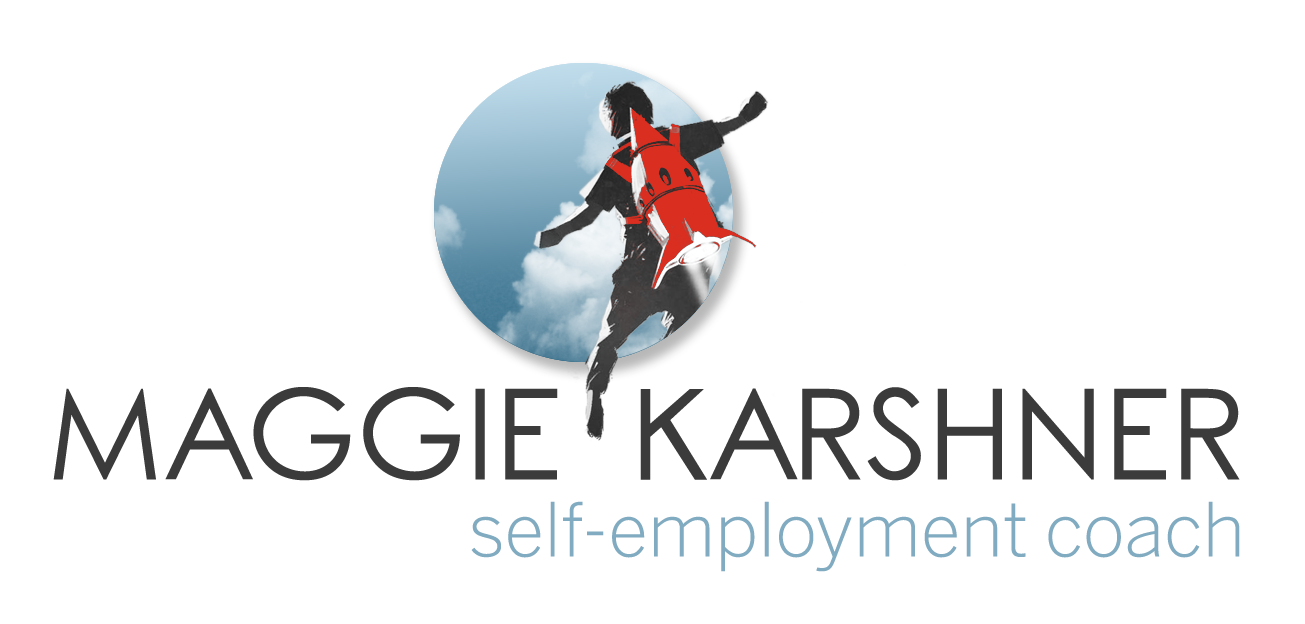4 Skills You Already Have That You Could be Using to Land Clients
/Image shows the title of the article laid over an image of two women sitting across a table from each other.
When we become self-employed, our success becomes contingent on some level of salesmanship. You're passionate about your work. So you've probably learned far more about serving clients than landing them. Sales trainings that could help you land clients are often designed for career sales-people. But you don't need to be making million-dollar deals! You just need this potential client to become an actual client. You actually already have skills to accomplish this! Here's how your current skills can help ensure you convert clients.
First I want to digress for a moment and differentiate "sales" from "marketing." For my purposes, I define "marketing" as promotional or awareness-building materials and activities. These are the earliest stages of the customer journey. The latter portion of the customer journey, if all goes well, is a sales conversation. A sale can happen without a conversation. (As evidenced by Amazon's "Buy Now" button.) However, if you're providing a service, then it probably won't. In order to build the necessary trust and comfort, a person will need to have a conversation with you before they commit to working with you. This article is about what happens in that conversation. Having a clear marketing message will help your sales conversation be tidy. But your marketing message is a topic for another day.
In a sales conversation you'll rely on four basic skills: listening, providing solutions, qualifying, and moving to close. The first two skills you've had some experience with, the latter two might seem new. We'll dive into each in a moment.
Before we get into the skills, I want to ground us in reality. Whenever you're having a conversation with a prospective client, remember that you do not need every client including this one. In fact, this client has the chance of being a terrible headache of a client! Maybe by no fault of their own: what if they have an expectation of what you do that is inaccurate? If you don't suss that out beforehand, then there are likely to be unpleasant feelings all around!
The goal of your sales conversation is not to land the client. Rather, it's to have the prospective client love you regardless of if they become your client. This means that ill-fitting clients are happily seen off to other solutions. While ideal clients are smoothly welcomed into your clientele. Our sales skills (listen, provide solutions, qualify, and move to close) differentiate which path the client needs to take and sends them on their way.
Listen
When conversing with someone it's important to listen. Listening can have many different objectives. When I listen to my favorite TV show I'm seeking to be entertained. When I'm listening to my best friend I'm seeking to connect. When meeting someone new we're often seeking to get to know them. With clients and prospective clients, we need to focus on what their needs are, even the ones that are not explicitly stated.
This requires attentive listening. Listening is a skill you probably use often and may even have been trained on. So I'm not going to belabor this point. Make sure you're attentive, you're noticing the nuance of what they're looking for, and asking clarifying questions as needed.
Provide Solutions
As we listen to someone's needs it can be easy to jump in with solutions. Sometimes these solutions are intangible: like when we provide comfort or consolation to someone in distress. Other times it's more tangible: like when someone's complaining about troublesome plumbing and you recommend your favorite plumber. Sometimes the speaker doesn't want a solution. This occurs when the speaker is intending to vent and be heard but is not ready for a solution. Your first role when thinking of solutions is to gauge what solution, if any, the speaker is ready for.
In a sales conversation one would hope that the speaker is ready for a solution and your service is that solution! You'd readily recommend your favorite professional to a friend in need. But when the professional we're recommending is ourselves, I notice we feel uncomfortable. There are ways to present yourself as a solution without braggadociously "recommending" yourself. You can clarify what you do, elaborate on an aspect of what you do, or share what you love about what you do. An easy phrase to have in your back pocket is: "When I work with clients on that, what I do is..." You can't assume that the premise of the conversation will do the work for you. You still have to clearly identify your service as the solution to the problem(s) they've brought up. This is what drives the sales conversation forward.
There is one more check when coming up with solutions: we need to gauge if it's actually something we can do. In the same way that you wouldn't recommend a plumber if you don't know any plumbers, we can't volunteer to do something we can't do. And this extends to things we don't do well or don't want to do.
It is so important NOT to jump in to help when you are legitimately not the best solution. Presenting yourself as the solution often prevents a more ideal solution from being found. Either the client walks away because you are not the right fit, or the client accepts your offer and it's not actually what they need. (Plus you're miserable in the process because it not actually what you do.)
Qualify
Qualifying might seem like a new concept, but this is the same internal mechanism that prevents you from hopping on a plane to Tahiti on a whim. We need to take time to consider, explore and come to a decision. This often overlooked part of sales purposefully slows down the sale. A sale should not be rushed; it'll only result in regret all around. So take that little extra time to ask for clarification. When your spidey-sense is telling you that something is off, but you're not sure if that feeling is accurate, this is the time to lean into the discomfort. Jump in and ask them to elaborate on that topic. "Tell me more about that" is an easy phrase to have on hand when it comes time for this.
This facet of sales is trying to save you the headache of having to fire a client down the road. I fully support firing clients, but it's no one's idea of a good time! While listening to and problem-solving for this prospective client, you're going to look for ideal client indicators. (Obviously, this is easier if you're already clear on who your ideal client is.)
This is also an opportunity to learn from our mistakes. If you've had difficult clients, then let's try to learn from that. With each difficult client, consider what went wrong, but also what happened before they were a client. What did you know about them when you agreed to take them on as a client? Is there something you could have learned about that client that was an indicator that the future difficulties lie ahead? What would that indicator show up as in conversation before they're a client?
Saying No by Saying Yes
When you do a good job of qualifying, it means you might find out you *don't* want to work with the person. So once you've had enough conversation that you're clear on that, then what? There is a way to get out of having them as a client, while also making them feel like you've provided a great service. The crux of this is to lead with the positive. Even as your brain is going "hell no!" Start your sentence with "Yes". This could be demonstrating they were heard by saying "Yes, [that thing they were just talking about] is very important..." Or "Yes, we [provide service they were asking about]..." And then we're going to use the power of "but." "But" negates everything that comes before it. So you'll lead with agreeing, and then close the sentence with "...but you'd be better served by [other solution.]" If you need to be super clear, you might opt for a: "Yes, we [provide service they were asking about] but we do not [specific aspect you do not do]. Perhaps you'd be better served by [other solution.]"
The "other solution" in these examples can be your competition. Take a lesson from Miracle on 34th Street, and be the Santa that sends people to the store next door. There is enough to go around. Plus the person you're sending elsewhere still has the opportunity to sing your praises as a trustworthy and reputable person.
Don't Forget to Close
Qualifying shouldn't get in the way of closing a deal with an ideal client. If things are going well, make sure you're driving the conversation towards them becoming a client. If you're a great solution for them, and all their concerns have been addressed, make sure you explain the next steps. And then make sure to follow up with those next steps or a reminder as needed.
Hone Your Skills
Next time you find yourself conversing with a prospective client, give some of this a try. Notice how you're advancing the conversation, or slowing down to qualify. Debrief with yourself afterwards about what went well and what could be improved. It's normal to get caught off guard from time to time. Plan a response for yourself so you'll have a smoother conversation the next time a client brings that topic up.




